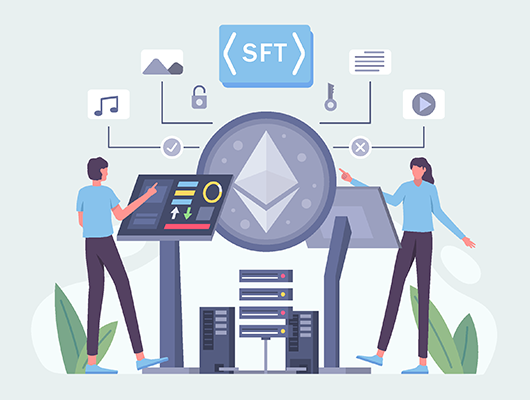Let's Discuss
Enquire NowInitially, in the crypto world, there are fungible tokens such as Bitcoins, which means that one token is the same as the other. Then there are non-fungible tokens, such as Bored Ape or CryptoKitties, where each token is unique and cannot be exchanged for another.
Then there are semi-fungible tokens, which exist alongside the other two tokens. SFTs are tokens that can transition from being fungible tokens like Ether to NFT. SFTs now have a limited application, primarily in the gaming industry.
Fungible & Non-Fungible Tokens
Before jumping into SFTs, let’s take a look at fungible and non-fungible tokens.
Fungible tokens are the ones that can be interchanged with another one. For example, one bitcoin can be exchanged for another bitcoin without any loss in its value. Traditional fiat currencies like USD or INR are also fungible.
On the other hand, Non-fungible tokens are blockchain-based tokens and they represent the ownership of a unique asset like a painting or a video, etc. This means that no 2 NFTs can be swapped with each other since their values are different.
What are Semi-Fungible Tokens?

Semi-fungible tokens are the ones that are initially fungible and can be traded with other identical SFTs. Upon redemption by the holder, these SFTs become non-fungible.
Consider purchasing a ticket to the final match of the IPL T20 cricket season. The ticket is worth a certain amount and is interchangeable with any other ticket from the exact match and seating class. After the game, the ticket is no longer valid for entry into the stadium but instead becomes a collector’s item, memorable for fans with a different value assigned to it.
In other words, using the ticket transforms it from a fungible token into a non-fungible token. Semi-fungible tokens get their name from this. SFTs, on the other hand, do not ‘expire’ in the same way, and instead, switch fungibility based on smart contracts pre-programmed into them by the SFT’s developer.
The best thing about SFTs is that they have fungible and non-fungible token characteristics. It becomes indivisible, verifiable, and indestructible when it becomes an NFT. When something is fungible, it is highly liquid and can be easily exchanged with anyone.
The creation of semi-fungible tokens
Currently, SFTs are only minted on the Ethereum network using the EIP-1155 standard. The EIP-1155 network standard is a hybrid of the EIP-20 (fungible) and EIP-721 (non-fungible) standards. This enables the creation and management of both fungible and non-fungible tokens with a single smart contract – a computer program that executes itself when certain conditions are met.
Advantages of semi-fungible tokens
Semi-fungible crypto tokens are chosen over fungible and non-fungible crypto tokens for a variety of reasons. The following are the benefits of semi-fungible tokens:
- Persists a fungible asset
Once exchanged from its original owner, the semi-fungible crypto coin retains its fungibility. This feature increases the liquidity of these tokens by retaining their face value across transactions
- Gaming industry
SFTs are currently in high demand, particularly in the (metaverse) gaming sector, to permit the exchange of play money for collectibles like additional equipment. For example, a token can begin as an NFT and then be used to produce play money, converting it to a fungible token. When this token is exchanged for a piece of equipment or a weapon, it changes back to an NFT.
- Non-fungible token representation
A semi-fungible token can also function as a non-fungible token or represent its subset. The function enables it to exchange partial assets in a game.
- Based on the Ethereum blockchain
Semi-fungible tokens are constructed on top of the Ethereum network.
As a result, the coins benefit from the existing infrastructure and cases.
- Flexibility
When compared to fungible and non-fungible tokens, semi-fungible crypto tokens are more adaptable. As a result, these tokens make gaming and playing more interesting for gamers and players.
They now can easily afford any weapon or equipment in the game. Using semi-fungible tokens also makes the development and coding process easier for developers.
Conclusion
The ERC-1155 standard, which was developed by blockchain gaming company Enjin, gave rise to SFTs. Today, the majority of ERC-1155’s application cases relate to video games. In the metaverse game Sandbox, for instance, SFTs are utilized to reproduce the same resources.
The conventional ticketing sector has run into issues. SFTs can be used as redeemable tokens, and once the event is over, they transform into NFTs that have collecting qualities. Similar to SFTs, vouchers may be provided as SFTs that convert to NFTs after being used for a purchase or until they expire.
Ideas for innovative projects buzzing in your mind? We can be the best development partner. Connect with us here to start something great!
Disclaimer: The opinions expressed in this article are those of the author(s) and do not necessarily reflect the positions of Dexlock.



